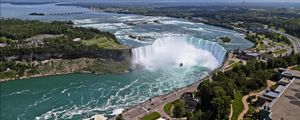I grew up visiting Niagara Falls regularly, and the torrential flow of the Niagara River has produced a significant portion of the energy I’ve consumed in my life. Niagara is a pivotal site in the history of electricity: the place where Nikola Tesla and George Westinghouse rolled out AC transmission at utility scale. But until I moved to Quebec and became infected with Quebecois enthusiasm for hydroelectricity, I mostly thought of it as the cheesy tourist town I used to visit as a kid.
Last week I went back for the first time in 20 years, and it was immediately clear why I hadn’t been tuned in to Niagara Falls’ energy legacy: All evidence of it has been deliberately hidden from sight.
The first layer of distraction is the surrounding town, which is rife with tourist traps. Niagara Falls straddles the border between New York and Ontario, and navigating the Canadian side involves an assault of sound and color as you wander through the carnivalesque atmosphere of Clifton Hill. Wax museums, haunted houses, Ferris wheels, and casinos vie for attention before you’ve even laid eyes on the main attraction.
The visual assault lessens as you make your way to the river, as the banks on both sides of the border are parkland. Viewing platforms offer up various angles to admire the three waterfalls that make up Niagara: Horseshoe Falls, Bridal Veil Falls, and the less imaginatively named American Falls. Often invoked as the quintessential example of the sublime in colonial American writing, the vast torrents still inspire awe tinged with just a little terror. But save for a pair of Nikola Tesla statues (one on each side of the border) there are no visual hints that this landscape is related to electricity production. The entirety of the hydroelectric infrastructure apparatus has been carefully hidden from tourist sightlines, with inlets upstream diverting water to power plants far downstream.
Today the waterfalls themselves are not particularly natural – as more water was diverted for electricity generation, the falls were reshaped, shored up, and carved up into aesthetically pleasing water features that would still look impressive with less water pouring over the top. As the historian Daniel Macfarlane explains, mid-century engineers embarked on a campaign of disguised design, sculpting the falls to allow more water to be diverted for electricity generation and turning the Niagara into “a flowing facade.”
Since the beginning of the industrial era, Niagara Falls has been a site of public negotiation and debate, weighing the inherent value of nature against the value of natural resources. The well-manicured parks, the deliberate invisibility of the generating infrastructure, and the fall’s facelift are compromises that aim to protect the natural beauty of the falls (and the value of the tourist dollars it attracts) while maximizing their industrial potential. As Macfarlane explains, Niagara Falls is something of a cyborg – partially natural, partially technological – both a spectacle for tourists and a source of power for the surrounding communities.
Read the full story
The rest of this post is for paid members only. Sign up now to read the full post — and all of Scope of Work’s other paid posts.
Sign up now



